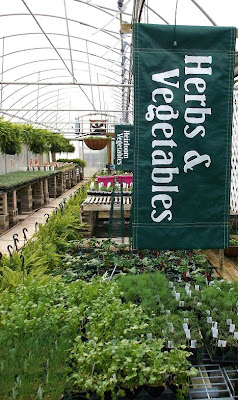Typically, as we head toward May we begin to envision
blooming flowers, warm breezes, fresh fruits and vegetables, and cooking with
fresh herbs. I am choosing to hold this imagery firmly in my mind despite the
terribly dismal temperatures we have been forced to endure as of late. And as a
result, I have decided to dedicate this entry to herbs…
Growing your own herbs is a terrific way to add diversity
and interest to your garden. Herb gardens produce at a rapid rate, and they are
fairly easy to maintain. They are great indoors (provided they have access to
sunshine) and outdoors, which means fresh seasonings all year round.
When planting an herb garden, I prefer small (4in.-6in.)
pots. These small pots would ideally house basil, thyme, parsley, and oregano. Larger
pots work well for herbs that maintain good flavor after maturity; including
bay, sage, and rosemary. Cilantro (coriander) grows best when planted outside
in the garden; it likes a lot of room to grow. Herbs like mint and chives will
come up every year and can be planted in pots, vegetable gardens, or even
incorporated into landscape design. However, these herbs do need a great deal
of supervision as they will attempt to take-over the bed.
Many herbs can be planted outside in the garden alongside
vegetables as companion plants. Companion planting is a method of planting that
demonstrates how some plants can do better with others beside them. Typically,
companion plants don’t compete for the same nutrients and can enhance the
health of each plant. A few very successful combos include: basil and tomato
(no surprise there), parsley and asparagus, and chives and carrots. This website is a great source for deciding which companion plantings would be right
in your garden.
Whichever planting method you choose, be sure to wait until
the plant has enough leaves to sustain growth after each cutting. Once herbs have hit their growing peak they
can be trimmed quite frequently. This is great later in the season since extra
trimmings means a chance for drying your own herbs!
I hope this entry was an insightful look at herbs and their
awesomeness! If you are ready to get your herb garden started, head on out to
the greenhouse. We have all the herbs I mentioned (plus a few more) ready to
go! Also, I couldn't resist posting one of Susie’s favorite recipes... her
amazing pesto! She makes this dish with fresh basil straight from her garden,
and now you can too!
Susie’s Pesto:
-Start with plenty of basil, at least 2 cups tightly packed
-Next, you will need garlic, 2 cloves is a good starting
point
-Then, you will
need pine nuts, for those of you who aren't sure about pine nuts you can check
them out here, ¼ of a cup should do
-And finally, just a little olive oil (start with ½ cup)!
You can combine the basil, garlic, and pine nuts in a food
processor or finely chop them by hand if you prefer (this will take quite a bit
of time). After the aforementioned ingredients have been combined, add in your
olive oil…
And that’s it. You are done! Susie will sometimes add a
little fresh parmesan cheese for an added kick.
**the one thing to keep in mind with this recipe is
everything is combine to taste, so there is a lot of room to play with this
fresh-herb concoction**
Be sure to follow us on...
Be sure to follow us on...
Pintrest: http://pinterest.com/strattonsgrhs/
Twitter: https://twitter.com/StrattonsGreen




